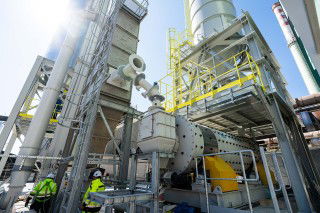This week ICR reported that HeidelbergCement was to change its name to Heidelberg Materials. This transformation towards a building materials company occurred gradually over the last century as the company diversified towards the wider building materials markets rather than restricting its growth to its cement business. The new name will reflect the change in company outlook but it will not change 150 years of cement history.
What’s in a name? HeidelbergCement will have considered long and hard about whether it need a corporate name change. The decision is not surprising considering that the cement industry is entering a difficult period where CO2 emissions are headline news and the cement sector is one of the largest emitters of this climate-changing greenhouse gas.
‘Materials’ is also more accommodating of the company’s balanced product mix, split between the cement, aggregates and ready-mix sectors, while allowing for further transformation of the company in future away from cement, as Holcim has done.
More than just cement
At the outset, the new Heidelberg Materials will have a balanced product mix between cement, aggregates and ready-mix sectors. Since 2019, when the company's cement deliveries reached 129.9Mt, HeidelbergCement has only seen a slight decline in cement deliveries to 126.5Mt in 2022, but its cement capacity in this period has been falling from 195.6Mta to 180.6Mta last year. Its ready-mix concrete deliveries peaked in 2021 at 50.7Mm3 and decreased to 47.4Mm3 in 2022. Aggregate deliveries have also seen a slight fall off from 309.4Mt in 2019 to 306.4Mt in 2022.
A new face and an anchor
The rebranding is more about perception than a vast change in the company's current portfolio, although this may be the signal that things are about to change.
Although Heidelberg Materials produces more aggregates than cement (by volume), this new name is an attempt to reposition the brand away from old-fashioned heavy building materials company, and this will surely sit easier with stakeholders and investors.
Dominik von Achten, Heidelberg Materials' CEO, remarked that the change was required because of, "a rapidly changing world where challenges and opportunities in sustainability and digitalisation go beyond country borders. We are meeting them by developing new solutions for our customers that go way beyond cement."
More importantly, Heidelberg Materials’ goal is to become a carbon-neutral company. This requires the company to evolve and the name change offers a reset button or start sign to how the company would like to be perceived going forward. "The rebranding gives our transformation a face and an anchor," he added.
Heidelberg Materials is investing in digitalisation and carbon capture, utilisation and storage (CCUS) and wants to be known for this. Indeed, it aims to be the first company to offer carbon-free cement by 2024. "We are proud of our cement business, but the company's range of services goes far beyond cement. Today and even more in the future," Dr Von Achten said. "Our future is sustainable. Our future is digital."
A change of focus
It has been more noticeable that HeidelbergCement has needed to make such a clear statement of its future direction than some of its rivals that do not have the word 'cement' in their names. But like HeidelbergCement, other multinationals are changing their approach to cement in how it is delivered and marketed and are moving quickly into other areas in the light and heavy building material sectors. This trend is set to continue as more diversification offers lower risk. HeidelbergCement has already stated that it aims to increase its revenue with sustainable products to share 50 per cent of group revenue by 2030. It is also becoming popular to pull back from emerging cement markets and to operate in the more mature markets of Europe and North America. HeidelbergCement has kept its options open, having divested in places such as Spain and the Balearic islands, as well as the more volatile markets of Sierra Leone and Kuwait. HeidelbergCement has not distanced itself from challenges though and could be considered brave to further its investment in Tanga Cementf in Tanzania, which could be considered a highly competitive cement market with large Chinese investment already committed in the region.
A new direction
While cement may play a less prominent role in the new Heidelberg Materials, it is still going to be a substantial part of its portfolio. HeidelbergCement's 'Beyond 2020 strategy' signalled the new vision for HeidelbergCement to concentrate on the megatrends of urbanisation, digitalisation and a low-carbon future. Those businesses that could not make a return on investment of eight per cent per annum were to be divested. The new bolt-on acquisitions will take Heidelberg Materials in a slightly different direction to its traditional core market in cement, but future investments are likely to be strongly guided by its new climate targets that seek to reduce CO2 emissions by 47 per cent from the 1990 baseline by 2030.
